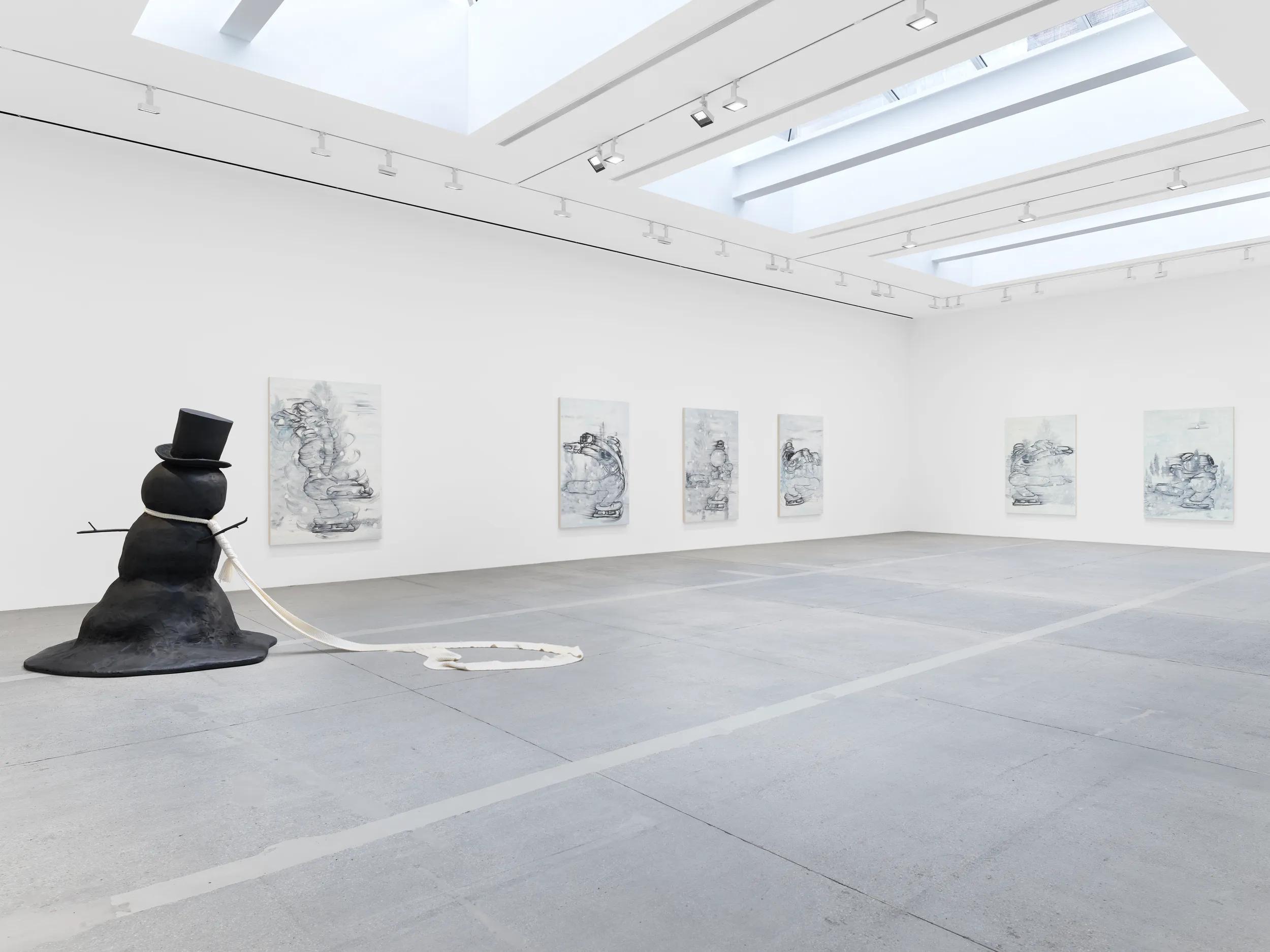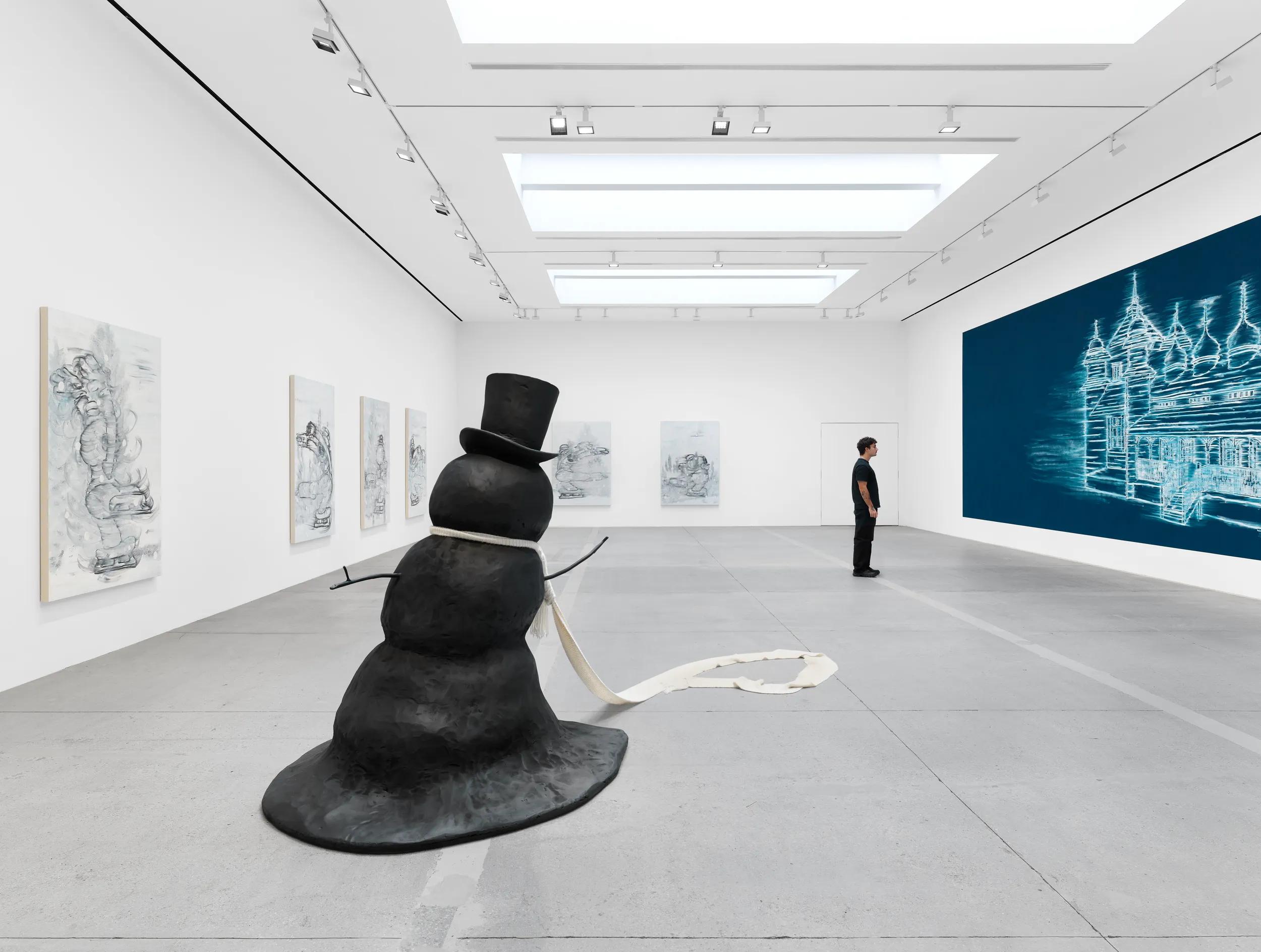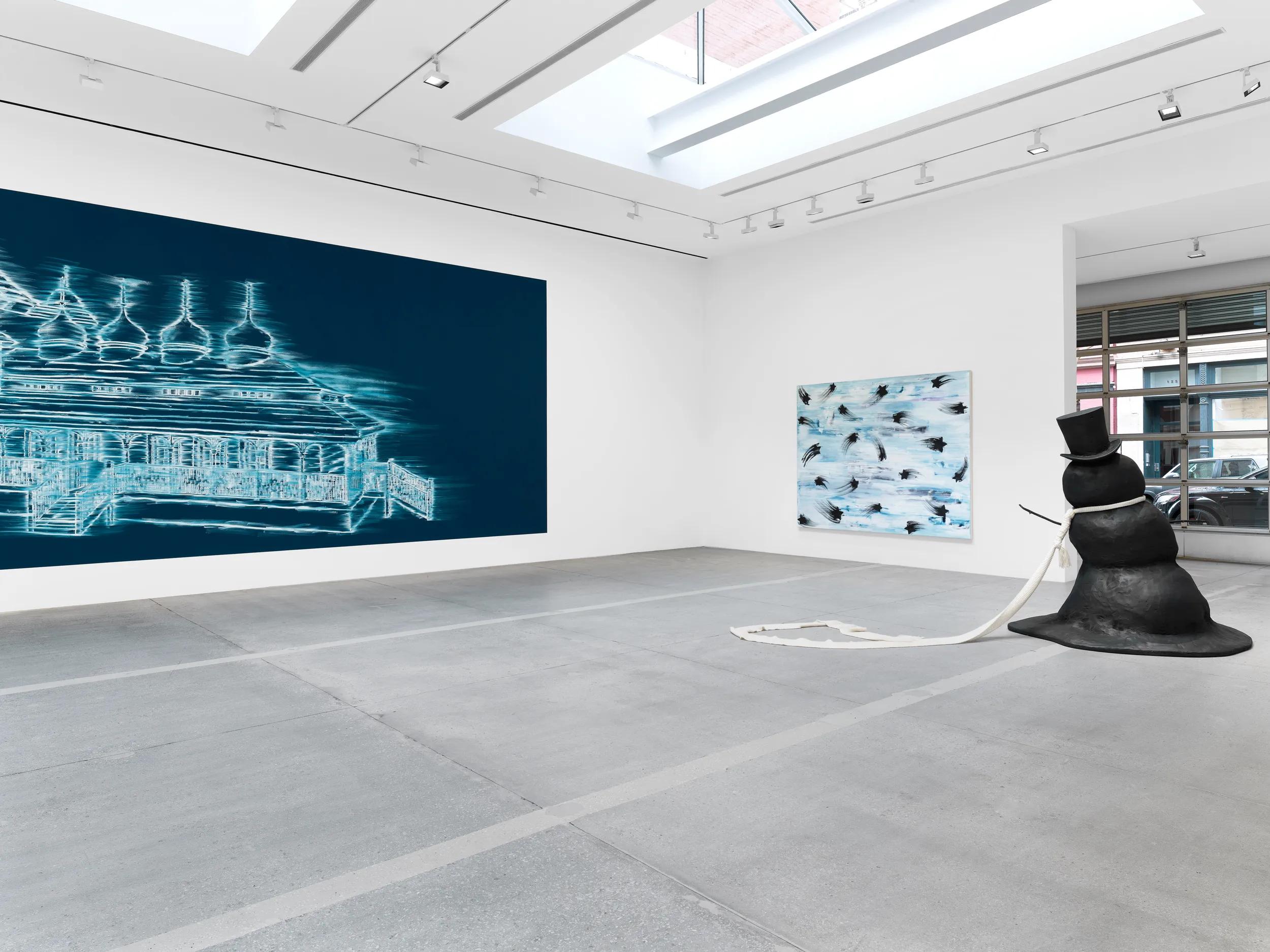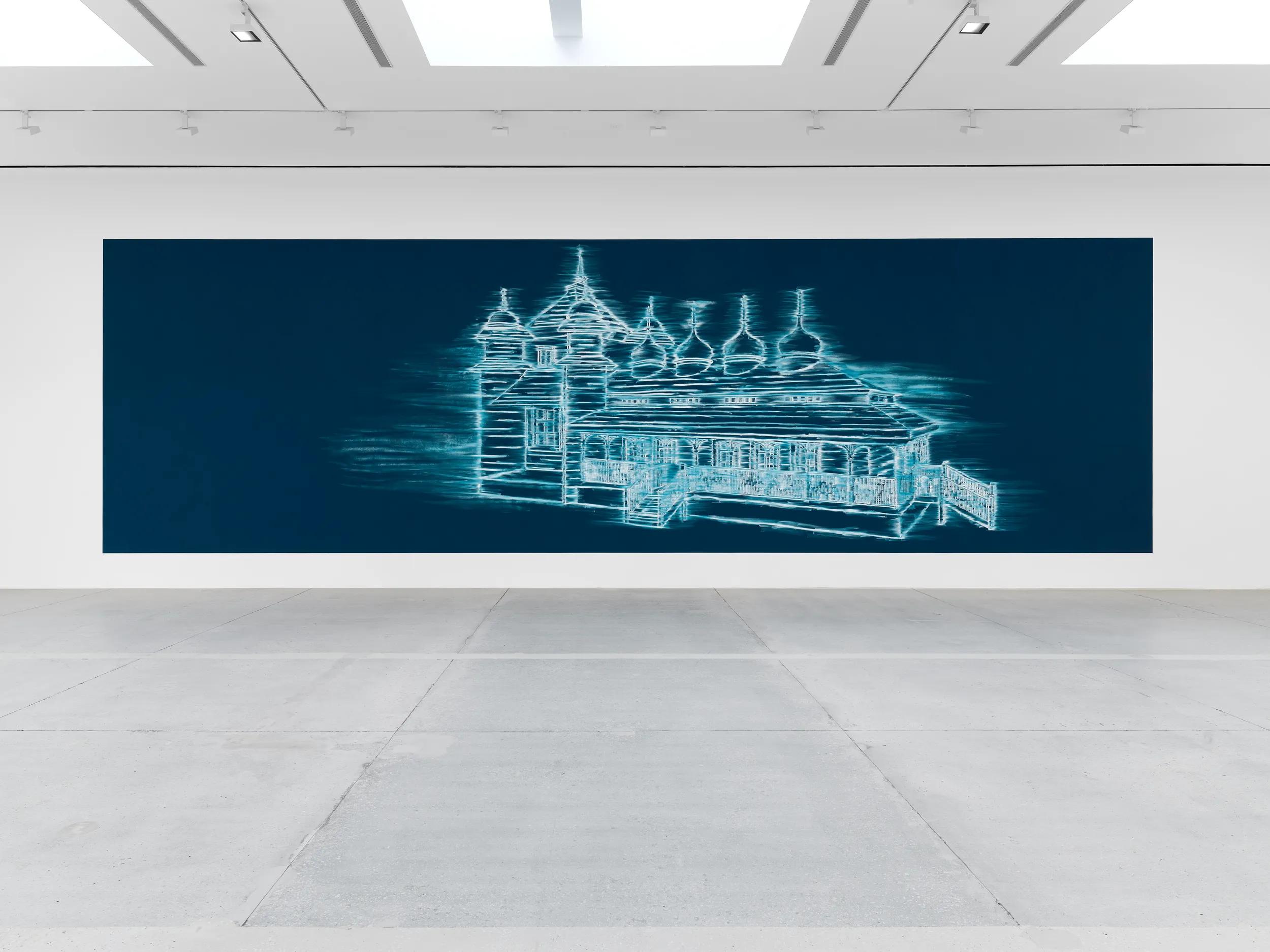For his first solo presentation with Hauser & Wirth in New York City, Gary Simmons will introduce a new body of work advancing his decades-long exploration into issues that haunt our national psychè—race, representation and collective identity. ‘Thin Ice’ debuts sculpture, paintings and drawings—including a sequence of canvases that isolate and re-purpose archetypical racialized imagery from cartoons of the 1920s and early 1930s, and a site-specific wall drawing referencing one of the most iconic films of the 1960s—to capture the instability and disorientation of the current American moment.
Simmons’ art skates deftly between abstraction and representation via his signature technique of erasure. This formal conceit upends the viewer’s sense of certainty; by degrading familiar icons, he exposes latent meanings and ugly truths lurking just behind the surface of popular imagery. For example, Simmons has consistently used Bosko and Honey, a pair of racist cartoon characters first created in 1928, as avatars of institutionalized racism.

Bosko reappears in ‘Thin Ice’ but with a new and unmistakable urgency. The exhibition opens with a painting that depicts him as a fiddle player frenetically sawing away at his strings. This work signals the start of a performance that will unfold across several successive canvases in which Bosko glides on ice skates to execute a single disjointed pirouette. Together the works achieve the effect of a stop motion film or comic strip. Simmons has blurred the contour lines of Bosko’s whirling figure, an expressive tactic that induces a vicarious sense of dizziness in the viewer.

Simmons' new site-specific wall drawing, ‘Somewhere, My Love,’ alludes to the unique material history of David Lean’s Academy Award-winning epic ‘Doctor Zhivago’ (1965) and adopts one of the film’s most memorable visuals—a lavishly ice-encrusted palace. Though its narrative is set in pale, frozen locales during World War I, ‘Doctor Zhivago’ was, in fact, filmed primarily during a winter heat wave in a staged Potemkin village erected near Madrid, Spain, where beeswax and dust from a local marble quarry were repurposed as imitation snow and ice. For Simmons, that feint becomes a stand-in for the artifice and seductive deceit coursing through popular culture and media—and, sometimes, by design, in art itself.

‘Thin Ice’ will also unveil a new sculpture replete with its own unique set of conceptual and physical paradoxes. Constructed from steel, foam and polyurethane, and finished with automotive paint, ‘Black Frosty’ (2024) resembles a snowman cast in obsidian or coal, his neck ensnared by a 20-foot-long, hand-knit noose made of white wool, suggesting an underlying violence often masked by civility.

An adjacent large-scale painting depicts a constellation of black stars streaming across a hazy blue and white sky, mirroring the inverted color palette of Simmons’ snowman. Here, the heavens are punctuated by points projecting the absence of light and ‘Black Frosty’ remains frozen in time, forever on the verge of dissolution.
Gary Simmons on The Edge of Reason
In the second season of our podcast with Atlantic Re:think, we explore the line where left-brain meets right-brain; where logic ends and creativity begins—beyond the edge of reason.
We engage with artist Gary Simmons and filmmaker dream hampton, who delve into the ways memory shapes our identities and our collective histories.
Related Content
About the Artist

Gary Simmons
One of the foremost artists of a generation which emerged during the late 1980s and early 1990s, Gary Simmons has achieved wide acclaim over the past three decades for his work which explores the politics of race, class and social stereotypes through painting, sculpture, sound and architectural environments. Simmons uses imagery drawn from popular culture to create works that address personal and collective memories.
Born in New York in 1964, Simmons received his BFA from the School of Visual Arts in 1988, and his MFA from CalArts in 1990, studying under the tutelage of Charles Gaines, Michael Asher, Catherine Lord, and others. Early in his practice, Simmons established a studio in a former school in New York City. At this stage, he was working predominantly in sculpture, a medium he would return to in subsequent decades. Works from this period, such as ‘Big Dunce’ (1989), use schoolroom objects to address racial inequality and institutional racism through the filter of childhood experience, themes seen most explicitly in ‘Six-X’ (1989), comprising six child-sized Ku Klux Klan uniforms hanging from a schoolhouse coatrack.
Simmons’ use of pedagogical motifs, in particular readymade chalkboards, led to the formal and aesthetic breakthrough that would inform much of his subsequent work, in which erasure of the image has been a powerful and recurring theme. Outlines of characters, scenes and words—based on 20th-century cartoons steeped in the racist traditions of minstrelsy, disappeared architectural sites, vintage film title cards, evaporating clouds of smoke and stars—are drawn or painted then blurred and smeared by hand. The tropes of erasure and ephemerality suggest the fleeting nature of memory and histories re-written. As the artist explains: ‘I started to think about how images on blackboards can never be fully erased. It was about trying to erase a stereotype and the traces of the racial pain that you drag along with you.’ A landmark piece commissioned for the Whitney Biennial, ‘Wall of Eyes’ (1993), picturing a smudged field of cartoon eyes drawn with chalk over slate paint applied directly to the wall, revealed the aesthetic possibilities of chalkboard at a monumental scale.
In further key commissions, Simmons has expanded beyond the confines of museum and gallery walls, creating performative and site-specific works which underline a relationship to a trajectory of art history that includes minimalism and conceptual art. For ‘Sky Erasure Drawings’ (1996), commissioned by the Museum of Contemporary Art Chicago, airplanes temporarily inscribed vapor stars in the daytime sky using liquid paraffin. For his immersive installation, ‘Fade to Black’ (2017), for the California African American Museum in Los Angeles, Simmons created five monumental wall drawings featuring the titles of vintage silent films and the names of largely forgotten African American actors in big typewriter-style letters blurred with ghostly traces. In a series of works from 2019, Simmons mined the architecture of surveillance through depictions of watchtowers and lighthouses. Deliberately ambiguous, these works collapsed the boundaries between signifiers of safety and those of control.
Simmons’ immersion in music has continually informed his practice which draws inspiration from dub, punk, hip-hop, reggae, and rap. Particularly influenced by the genres’ race and class-focused politics, the artist has created a number of works tracing the voices in music that have shaped contemporary culture. Simmons attracted significant critical attention in 2014 for his stacked speaker piece ‘Recapturing Memories of the Black Ark’. Inspired by Jamaican sound systems, the work is a living sculpture, with performers invited to activate it and then leave the configuration they utilized behind until the next performance. The work’s ongoing history offers both a contrasting and complementary approach to the record of the past offered by the artist’s erasure paintings.
For a site-specific installation commissioned for Culture Lab Detroit in 2016, Simmons was inspired by the guerrilla marketing style of fly-posting to promote gigs. Using found posters sourced from flea markets and the internet, he manipulated the originals, saturating the colors or reworking the texts, before layering onto the wall. This process has subsequently made its way into other works on plywood and canvas that evoke the fragmentation between individual and collective memory that preoccupies much of Simmons’ practice.
In his most recent works, Simmons continues to engage with popular culture, however, in an increasingly nuanced and abstracted way, as his focus shifts towards the history and materiality of painting and sculpture. Simmons has also reintroduced racist cartoon characters such as Bosko and Honey from the Looney Toons franchise and the crows from Disney’s film, ‘Dumbo’. Combined with the use of erasure, the artist references the attempt to cover up the engrained prejudices revealed by the popularity of such cartoons. Though these subjects first appeared in Simmons chalkboard drawings from the early 1990s, his newest works demonstrate an exploration of painterly issues such as background, depth of field, process and layering, citing Albert Oehlen and Martin Kippenberger as influences. The process involves a constant building and removal of up to fifteen layers of paint, evoking layered histories lying deep beneath the canvas. Simmons likens this effect to aged chalkboards, containing the traces of years of markings.
Gary Simmons has been the subject of solo exhibitions both nationally and internationally, including Henry Art Gallery, Seattle; California African American Museum, Los Angeles; Modern Art Museum of Fort Worth; and Kunsthaus Zürich. Selected group exhibitions include Museum of Modern Art, New York; Walker Art Center, Minneapolis; and Stedelijk Museum, Amsterdam; among others. Simmons was featured in Thelma Golden’s landmark 1994 ‘Black Male’ exhibition at the Whitney Museum of American Art in New York, Franklin Sirmans’ 2014 Prospect Triennial in New Orleans, and Okwui Enwezor’s ‘All the World’s Futures,’ for the 2015 Venice Biennale.
In 2021, Simmons was appointed a National Academician by the National Academy of Design. He is the recipient of the Joyce Alexander Wein Prize, Studio Museum of Harlem; USA Gund Fellowship; Penny McCall Foundation Grant; National Endowment for the Arts Inter-Arts Grant; and the Aspen Award for Art.
The first comprehensive institutional survey of Simmons’ work, ‘Gary Simmons: Public Enemy,’ was on view at Museum of Contemporary Art Chicago in 2023 and traveled to Pérez Art Museum Miami from 2023 – 2024.
Current Exhibitions
1 / 12



















